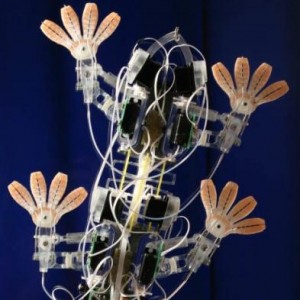June’s Nanoscale Informal Science Education (NISE) Network newsletter features a 2009 video, Nanotechnology brings us Delicious Nanocrystalline solar cells, which was entered for the American Chemical Society’s 2009 Nanotation Nanotube contest.Who knew you could use donuts and tea to make a solar cell?
ETA June 20, 2011: Dexter Johnson in a June 17, 2011 posting on his Nanoclast blog points out that the science in this video is not of the best calibre.
On another note entirely, an April 22, 2010 posting from Clark Miller on the NISE Net blog focuses on bio-non-bio interfaces. Excerpted from Miller’s posting,
What would it mean if biological and non-biological systems were not just fully connectable but fully interchangeable? That’s one of the questions that nanotechnology poses for us. More than any other field of scientific inquiry, nanotechnology operates at the basic scales of biology. DNA, for example, has a rough width of 2.5 nm. Viruses are roughly 20 to 250 nm. A bacteria is roughly 1000 nm. So, nanotechnology spans from the scale of individual biological molecules through the scale of simple biological systems to the scale of living cells.
Miller certainly poses an interesting question especially in light of work which could conceivably lead (or perhaps already has led) to interchangeable biological and nonbiological systems,
For example, researchers at the University of Wisconsin-Madison have developed a new sensor for viruses that works through a combination of nanotechnology elements. The base of the sensor is a flat basin filled with liquid crystals (these are crystal molecules that behave like a liquid and form the core materials used in computer and flat-screen TVs). Within the basin are a series of parallel ridges approximately 5 nm on each side. These ridges help orient the liquid crystals so that they line up in parallel to the ridges and therefore exhibit a constant color across the entire basin. Finally, set into the ridges are a series of antibody particles for a specific virus. Once built, the sensor is exposed to material that might contain the virus in question. If the virus is present, it will bind to the antibody and, when it does, disturb the arrangement of the liquid crystals. When the liquid crystals are disturbed, the sensor changes color, signaling a positive match.
I haven’t seen any public engagement exercises that raise the issue in quite that way. At this point, it seems to be the province of science fiction.
Before I finish this posting with the June 2011 Nano Haiku, I’ll give you a little information about the article by Anne Trafton that inspired it, Finding a needle in a haystack: New sensor developed by MIT chemical engineers can detect tiny traces of explosives,
MIT [Massachusetts Institute of Technology] researchers have created a new detector so sensitive it can pick up a single molecule of an explosive such as TNT.
To create the sensors, chemical engineers led by Michael Strano coated carbon nanotubes — hollow, one-atom-thick cylinders made of pure carbon — with protein fragments normally found in bee venom. This is the first time those proteins have been shown to react to explosives, specifically a class known as nitro-aromatic compounds that includes TNT.
And now the Nano Haiku,
Bee venom and nanotubes
Raise nano red flags
For super small explosivesby Vrylena Olney of the Museum of Science, Boston.
